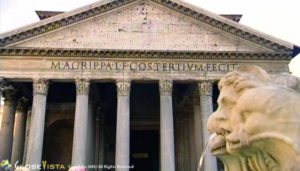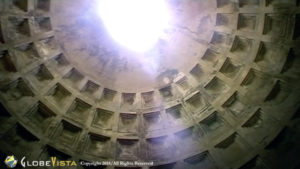
The Pantheon stands proudly in the Piazza della Rotonda, and is the only building of ancient Rome which remains perfectly preserved. This is remarkable, considering the temple has been damaged and plundered over the centuries. The Pantheon was built in c.AD 120 by Emperor Hadrian, replacing the original temple built which was built in 27BC, by Marcus Agrippa. Agrippa’s name can be found inscribed over the entrance. The circular temple was originally dedicated to the gods of the seven planets. In 609 it became a Christian church dedicated to St Mary of the Martyrs.
Architecturally Astonishing

The dome is considered to be one of the great architectural feats of Ancient Roman. The opening in the center of the roof, the oculus (eye), symbolised the sun and was used to carry off smoke from the central altar. The oculus measures 8.1m in diameter. The floor was built slightly concave with a drain in the center to remove water from the rain that entered through the oculus. The 43.2m diameter dome was built from concrete. The Romans were the first to use concrete for construction, mixing volcanic soil with lime and other materials. Molds were used to create the rounded tops and were then hoisted up onto a rotunda (round building). The thickness and type of concrete varies between the top and bottom of the dome to help reduce the weight of the dome. The base of the dome is 6m thick and near the oculus only 2.3m thick. There are 20 Corinthian columns at the entrance of the Pantheon each with a diameter of 1.5m.
Who Is Buried In the Pantheon?
King Victor Emmanuel II and King Umberto I (as well as Umberto’s Queen, Margherita) are buried in the Pantheon. Others buried there are the painters Raphael and Annibale Caracci and the architect Baldassare Peruzzi. Evidently, volunteer members of Italian monarchist organisations maintain a vigil over the royal tombs, despite the fact that Italy has been a republic since 1946. The Pantheon still remains a church and Masses are still celebrated there.
Piazza della Rotonda
The square, Piazza della Rotonda, in front of the Pantheon was used as a market until 1847. The square became infamous for the execution of a merchant who was selling sausages made from human flesh (charming!).
The Pantheon Fountain (Fontana del Pantheon) was designed by Jacopo della Porta in 1575 and was sculpted by Leonardo Sormani.
